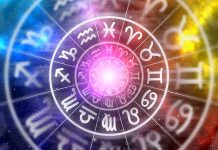
Do you like cereal? Well, you can thank the Roman goddess Ceres for your CoCoa Krispies. The word for your favorite grains, swimming in your oat milk, comes from the mythological namesake of the little dwarf planet Ceres.
Sweet little Ceres doesn’t get enough attention in astrology or even in the mainstream discussion of our solar system. While she is only 1/14th the size of Pluto, she is the only dwarf planet in the asteroid belt between Mars and Jupiter. Ceres alone comprises more than 25% of the total mass in the belt, making all the other asteroids seem tiny in comparison.
Cool Facts About Ceres
Ceres was discovered by the Italian astronomer Giuseppe Piazzi in 1801. Initially classified as a planet, she was later reclassified as an asteroid due to the discovery of other similar objects in the region. As humanity learned more about our solar system, it was discovered that Ceres is a unique and potentially fascinating world in our solar system. She was finally designated as a dwarf planet by the International Astronomical Union (IAU) in 2006.
With a diameter of only 590 miles, she has a nearly spherical shape and a relatively low density, suggesting a composition consisting of a rocky core surrounded by an icy mantle. The coolest features of Ceres are the presence of bright spots on her surface and her possibility of being able to sustain life. The bright spots are composed of highly reflective salts. The bright spots may be evidence of ice volcanoes, where materials, including water, erupt to the surface. As for sustaining life, the presence of the water and organic materials on the surface are exciting for scientists who are studying Ceres.
The Archetype and Mythology of Ceres
In ancient Roman mythology, Ceres was the goddess of agriculture, grain crops, and fertility (thus the connection to cereal). She symbolizes the abundance of the Earth and the cycle of growth and harvest.
Ceres, known as Demeter in Greek mythology, was the daughter of Saturn (Kronus) and Ops (Rhea) and the sister of Jupiter (Zeus), Neptune (Poseidon), and Pluto (Hades). She was part of the twelve Olympian deities and held a prominent place in the Roman pantheon.
According to the myth, Ceres was deeply devoted to her daughter, Proserpina (Persephone), who was abducted by Pluto and taken to the underworld. Consumed by grief and despair, Ceres wandered the Earth in search of her daughter, neglecting her duties and causing famine, drought and infertility in the process.
Jupiter begs Ceres to stop the madness and heal the Earth, but she refuses unless she gets her daughter back. As a result, Jupiter makes a deal with Pluto to share Proserpina with Ceres. Ceres gets time with her daughter in the spring and summer, and Pluto gets her back in the fall through the winter. This myth explains the seasons, as all the plants, flowers and trees fade for half the year while Ceres misses her daughter during each half year in the underworld.
What Does Ceres Mean in Astrology?
Ceres, much like the goddess archetype, represents themes of nurturing, sustenance, fertility, and the cycles of life and death in astrology. It embodies the energy of the caregiver and the provider. In astrology, Ceres is often associated with our connection to nature, and our ability to nourish and be nurtured.
In an individual natal chart, Ceres highlights areas of life where you may express or seek nurturing, as well as where you have the potential to provide care and sustenance to others. The sign, house and aspect placement of Ceres play a role in determining the specific characteristics and expressions of this energy.
For instance, Ceres in nurturing and sensitive Cancer may emphasize a strong bond with the mother or a deep need for emotional security. In contrast, Ceres in practical and earthy Taurus may emphasize a nurturing approach rooted in stability, sensuality, and material comforts.
Additionally, the house placement of Ceres in an individual’s chart may provide insights into the areas of life where nurturing, nourishment, and caretaking may be most prominent. For example, Ceres in the fifth house may highlight this archetype expressed through creativity, children, or romantic relationships.
As the Earth Mother archetype, Ceres also symbolizes our connection to the Earth and our responsibility to nurture and care for our planet. Our need for this archetype in astrology (and this vibe in the world) has potentially never been greater than in the years since Ceres was upgraded to dwarf planet. As always, astrology shows these things always seem to happen right when we need them to show the evolution in our human experience through time. Her placement and aspects in the charts of individuals interested in environmental activism or with a strong connection to nature can provide insights into contemporary sensibilities and concerns.
The Future of Ceres
It’s worth noting that the interpretation of Ceres in astrology is still evolving, and different astrologers may have varying perspectives on its significance. Astrology has evolved for thousands of years, and it often takes a very long time to truly study and flesh out how an archetype plays in the real world or an individual chart.
Ceres will likely reveal a darker side as a personality archetype as well, shown through her willingness to let the world die while she grieved the loss of her daughter. The use of the Ceres archetype to further our understanding the psychological underpinnings of our inner traumas may be incredibly helpful to anyone on a deep self-exploration.
Will Ceres end up ruling a sign like Virgo or Taurus that share their ruling planets with other signs, like Pluto rules Scorpio? While that is a question that hasn’t been answered yet, Taurus could certainly be a candidate. Taurus shares Venus with Libra and could potentially be in line with the Earth Mother Ceres archetype through its association with the Earth, food, and sustenance. Virgo, another Earth sign that shares Mercury with Gemini, might also be possible, but Virgo’s health and service vibe might be more in line with Chiron.
Ceres is worthy of study and astrology will only benefit from adding her archetype to charts, horoscopes, and our humanity.
Copyright 2024 Astrovibe.com


















